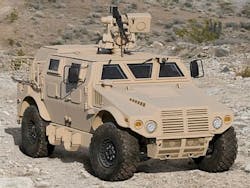Navy eyes tactical vehicle-mounted UAV-killing laser to defend Marines while on the move
ARLINGTON, Va., 3 April 2013. U.S. Navy researchers are taking the first steps toward a tactical laser weapon mounted on a humvee-like maneuverable combat vehicle to protect moving U.S. Marine Corps task forces from unmanned aerial vehicles (UAVs), cruise missiles, and other weapons that are difficult to pick up on radar.
The Office of Naval Research (ONR) in Arlington, Va., released a formal industry solicitation last Thursday (13-SN-0014) for the Ground–Based Air Defense Directed Energy On-The-Move program (G-BAD DE OTM), which seeks novel subsystems and components for a future UAV-killing laser vehicle that can fire on the move.
The U.S. Army is investigating laser vehicles such as the Boeing truck-mounted High Energy Laser Technology Demonstrator (HEL TD) to defend Army troops against UAVs, rockets, artillery shells, mortars, and similar threats.
The big difference, however, is firing on the move. The HEL TD, which has been demonstrated at White Sands Missile Range in New Mexico, is designed to move to deployed Army sites and engage targets from fixed sites. The future Marine Corps G-BAD is envisioned to fire laser weapons while maneuvering with moving Marine Corps air-ground task forces.
While the Army HEL-TD program seeks to mount a 10-kilowatt laser weapon on a 10-ton eight-wheel truck to engage targets from a distance, the G-BAD initiative seeks to mount a short-range air-defense laser at least as strong as 25 kilowatts on a four-wheel The Joint Light Tactical Vehicle (JLTV), which the Army, Marines, and Special Operations forces are developing to replace the Humvee.
Navy researchers are looking at a G-BAD laser weapon that can fire at full power for as long as two minutes, followed by a 20-minute recharge to 80 percent of total capacity. The laser weapon should not weigh more than 2,500 pounds, and needs to fit in the JLTV's cargo area.
Marine Corps officials say current low-altitude air-defense systems have weaknesses against UAVs, which are becoming armed threats, and say they need something like the G-BAD concept as a new expeditionary mobile air-defense weapon. The G-BAD concept will be developed from the ground up to prevent reconnaissance, surveillance, targeting, and engagement of expeditionary forces by UAVs.
The G-BAD system will consist of three subsystems a volume-surveillance radar, command and control (C2), and a high-energy laser weapon. Navy researchers envision the G-BAD laser weapon ultimately for the JLTV, but the first demonstrations most likely will be on a M1152A1 humvee.
For now, the G-BAD program aims to identify, develop, and mature novel key components and subsystems that not only improve Marine Corps air-defense capability, but also offer reductions in size, weight, and power consumption, and that can operate effectively on-the-move.
Navy researchers primarily are interested in high-energy laser sources of at least 25 kilowatts that are small, rugged, high-efficiency, and with good beam quality. Eventually researchers want a JLTV-mounted 50-kilowatt laser weapon.
Other laser weapon technological areas of interest include a rugged, lightweight beam director; improved beam control; adaptive optics; an atmospheric characterization and tactical decision aid; thermal storage and management; power generation, storage, and conditioning; weapon station controls and displays; and long range optics.
For now, Navy researchers are not trying to procure a high-energy laser weapon. Instead, they are focusing on developing technologies and components for such a future system.
Companies interested in participating in the G-BAD program should respond with white papers no later than 26 April 2013, and with full proposals no later than 7 June 2013.
ONR scientists say they plan to award several contracts worth as much as $400,000 each for this solicitation, although they will consider proposals outside of this cost range. Projects may last for as long as four years.
For technical questions or concerns, email the ONR G-BAD program manager, Lee Mastroianni at [email protected], or project manager Stuart Shoppell at [email protected]. For contracting questions email contract specialist Frank Kennedy at [email protected].
More information on the G-BAD solicitation is online at https://www.fbo.gov/spg/DON/ONR/ONR/13-SN-0014/listing.htm.

